BUS803 Globalization: A Critical Analysis of Trump Era Impact
VerifiedAdded on 2023/06/04
|8
|2864
|344
Essay
AI Summary
This essay provides a critical analysis of globalization in the age of Trump, evaluating various perspectives on the issue. It examines the factors influencing internationalization despite geopolitical challenges, focusing on political, technological, and economic globalization. The essay argues that while Trump-era policies may reduce globalization, they won't eliminate it entirely, as firms can adopt strategies to maintain trade relations and expand strategically. It highlights the importance of bilateral ties, cultural similarities, and technology in sustaining globalization. The analysis also discusses the impact of weak performance and protectionist policies, suggesting strategies like adaptability, arbitrage, and aggregation for firms to thrive in the changing global landscape, emphasizing the need for firms to adapt to changing demand and leverage international differences to enhance profitability.
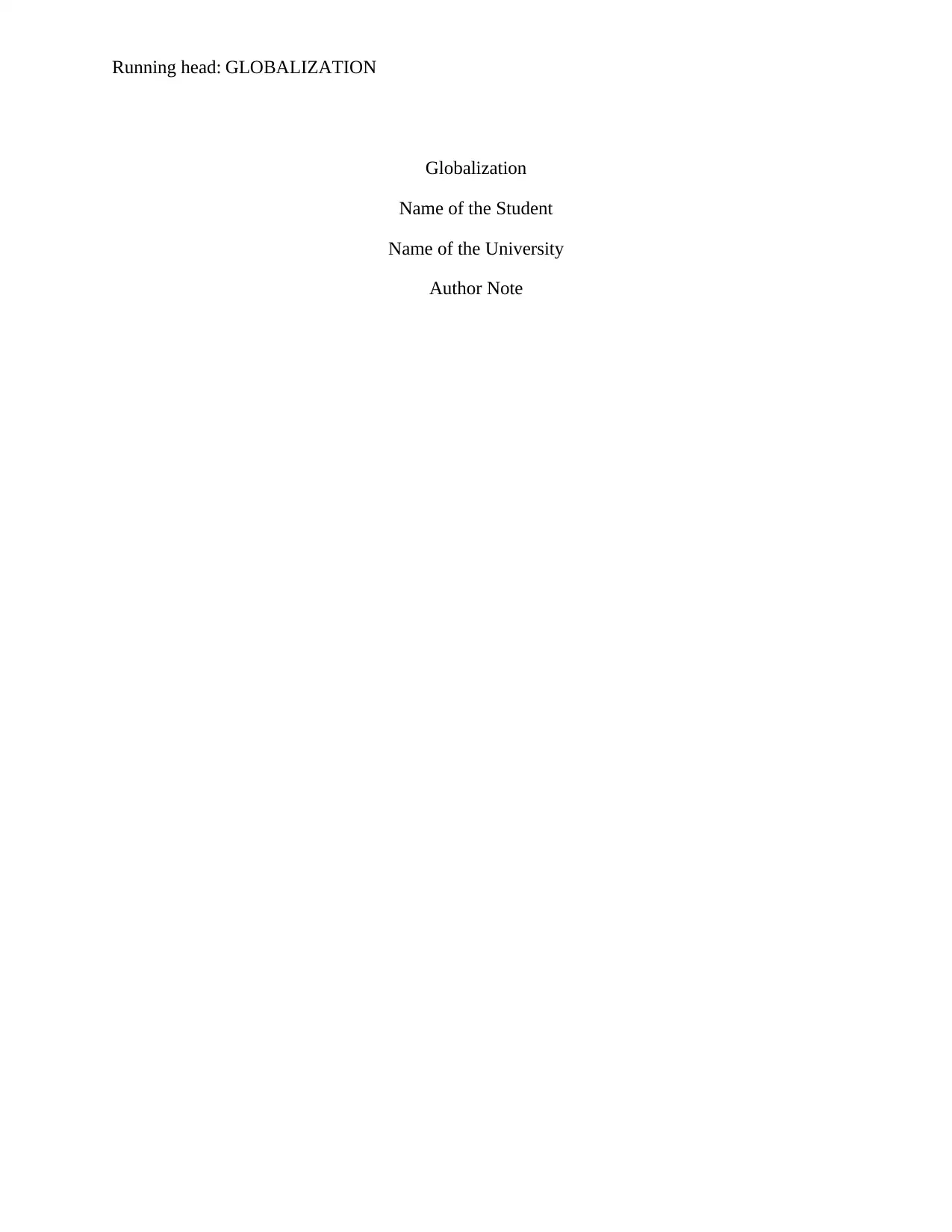
Running head: GLOBALIZATION
Globalization
Name of the Student
Name of the University
Author Note
Globalization
Name of the Student
Name of the University
Author Note
Secure Best Marks with AI Grader
Need help grading? Try our AI Grader for instant feedback on your assignments.
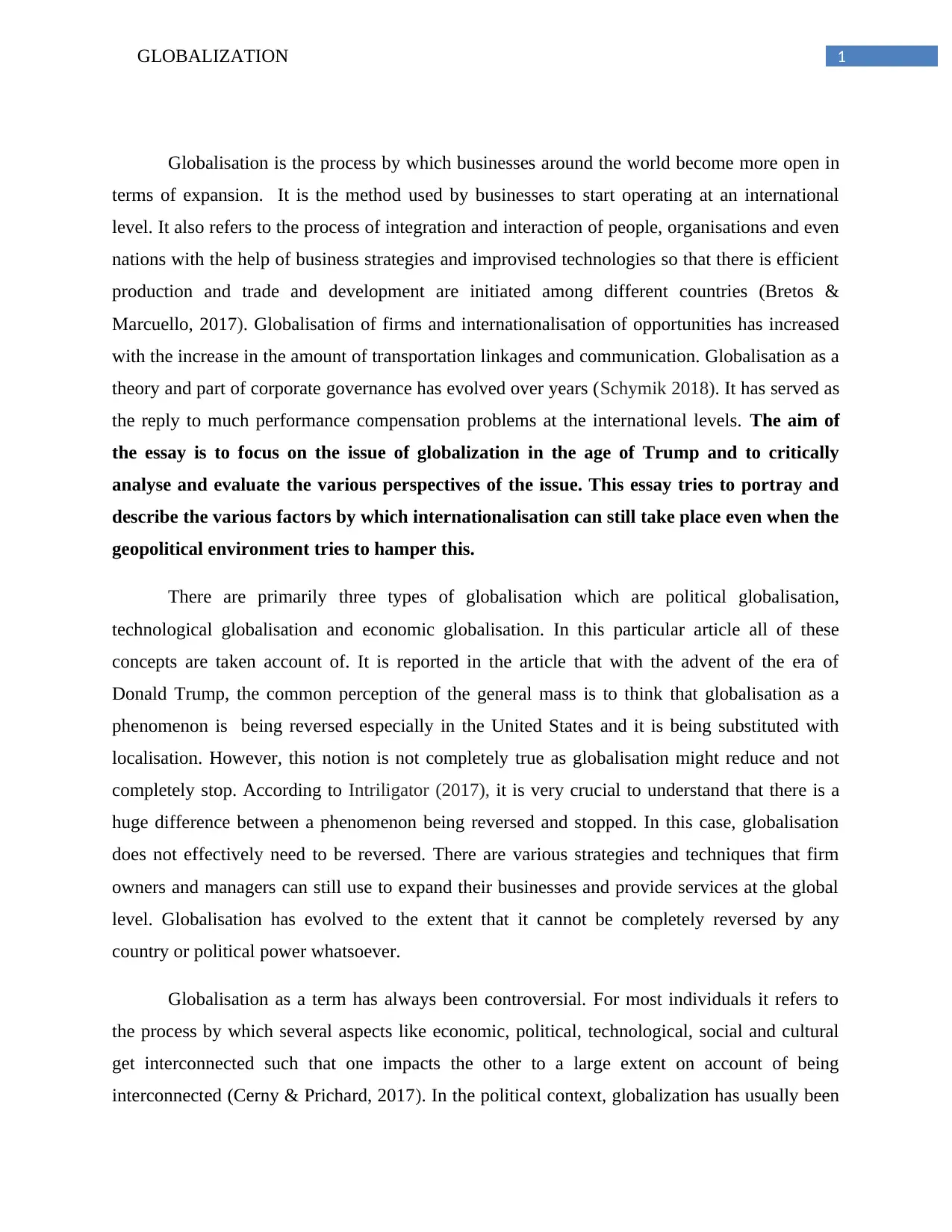
1GLOBALIZATION
Globalisation is the process by which businesses around the world become more open in
terms of expansion. It is the method used by businesses to start operating at an international
level. It also refers to the process of integration and interaction of people, organisations and even
nations with the help of business strategies and improvised technologies so that there is efficient
production and trade and development are initiated among different countries (Bretos &
Marcuello, 2017). Globalisation of firms and internationalisation of opportunities has increased
with the increase in the amount of transportation linkages and communication. Globalisation as a
theory and part of corporate governance has evolved over years (Schymik 2018). It has served as
the reply to much performance compensation problems at the international levels. The aim of
the essay is to focus on the issue of globalization in the age of Trump and to critically
analyse and evaluate the various perspectives of the issue. This essay tries to portray and
describe the various factors by which internationalisation can still take place even when the
geopolitical environment tries to hamper this.
There are primarily three types of globalisation which are political globalisation,
technological globalisation and economic globalisation. In this particular article all of these
concepts are taken account of. It is reported in the article that with the advent of the era of
Donald Trump, the common perception of the general mass is to think that globalisation as a
phenomenon is being reversed especially in the United States and it is being substituted with
localisation. However, this notion is not completely true as globalisation might reduce and not
completely stop. According to Intriligator (2017), it is very crucial to understand that there is a
huge difference between a phenomenon being reversed and stopped. In this case, globalisation
does not effectively need to be reversed. There are various strategies and techniques that firm
owners and managers can still use to expand their businesses and provide services at the global
level. Globalisation has evolved to the extent that it cannot be completely reversed by any
country or political power whatsoever.
Globalisation as a term has always been controversial. For most individuals it refers to
the process by which several aspects like economic, political, technological, social and cultural
get interconnected such that one impacts the other to a large extent on account of being
interconnected (Cerny & Prichard, 2017). In the political context, globalization has usually been
Globalisation is the process by which businesses around the world become more open in
terms of expansion. It is the method used by businesses to start operating at an international
level. It also refers to the process of integration and interaction of people, organisations and even
nations with the help of business strategies and improvised technologies so that there is efficient
production and trade and development are initiated among different countries (Bretos &
Marcuello, 2017). Globalisation of firms and internationalisation of opportunities has increased
with the increase in the amount of transportation linkages and communication. Globalisation as a
theory and part of corporate governance has evolved over years (Schymik 2018). It has served as
the reply to much performance compensation problems at the international levels. The aim of
the essay is to focus on the issue of globalization in the age of Trump and to critically
analyse and evaluate the various perspectives of the issue. This essay tries to portray and
describe the various factors by which internationalisation can still take place even when the
geopolitical environment tries to hamper this.
There are primarily three types of globalisation which are political globalisation,
technological globalisation and economic globalisation. In this particular article all of these
concepts are taken account of. It is reported in the article that with the advent of the era of
Donald Trump, the common perception of the general mass is to think that globalisation as a
phenomenon is being reversed especially in the United States and it is being substituted with
localisation. However, this notion is not completely true as globalisation might reduce and not
completely stop. According to Intriligator (2017), it is very crucial to understand that there is a
huge difference between a phenomenon being reversed and stopped. In this case, globalisation
does not effectively need to be reversed. There are various strategies and techniques that firm
owners and managers can still use to expand their businesses and provide services at the global
level. Globalisation has evolved to the extent that it cannot be completely reversed by any
country or political power whatsoever.
Globalisation as a term has always been controversial. For most individuals it refers to
the process by which several aspects like economic, political, technological, social and cultural
get interconnected such that one impacts the other to a large extent on account of being
interconnected (Cerny & Prichard, 2017). In the political context, globalization has usually been
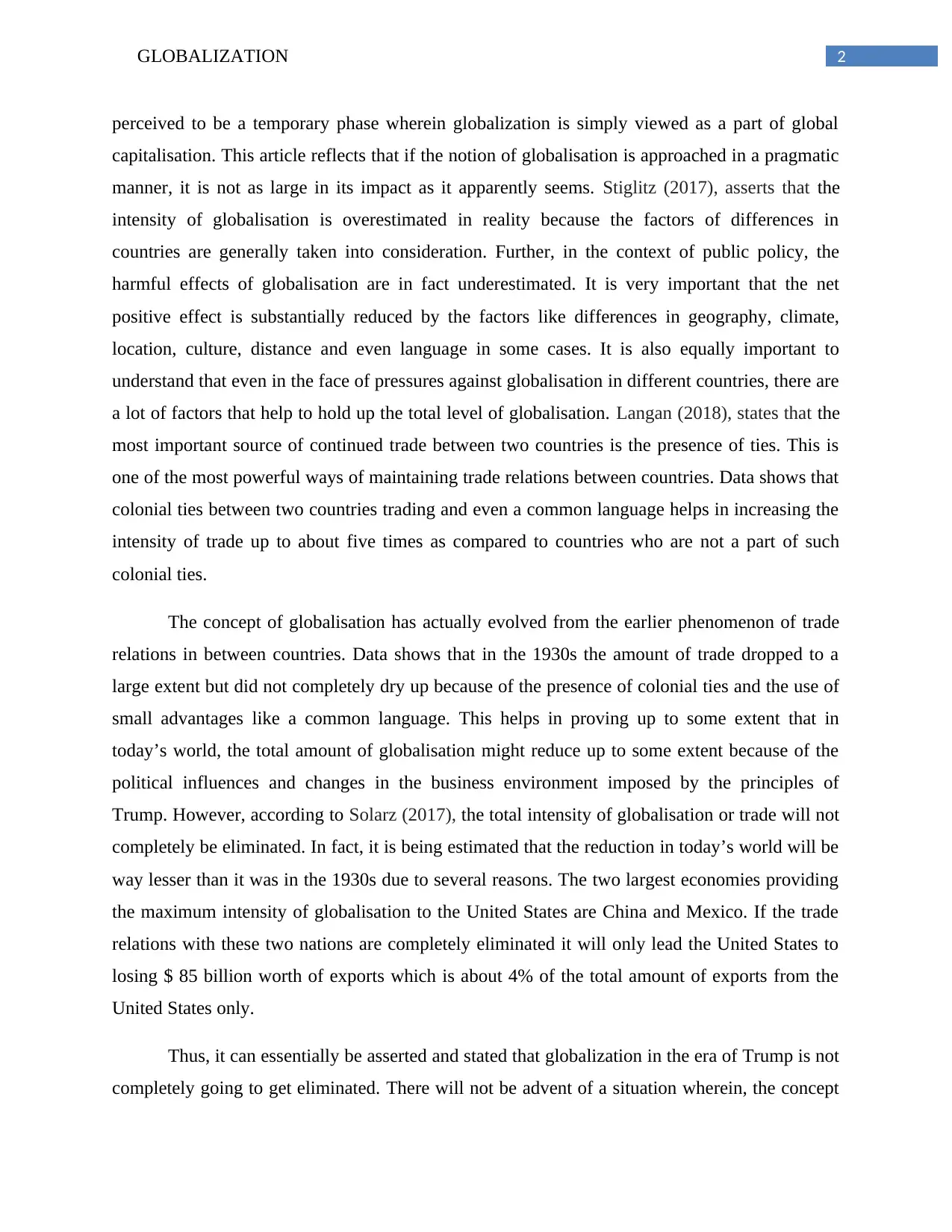
2GLOBALIZATION
perceived to be a temporary phase wherein globalization is simply viewed as a part of global
capitalisation. This article reflects that if the notion of globalisation is approached in a pragmatic
manner, it is not as large in its impact as it apparently seems. Stiglitz (2017), asserts that the
intensity of globalisation is overestimated in reality because the factors of differences in
countries are generally taken into consideration. Further, in the context of public policy, the
harmful effects of globalisation are in fact underestimated. It is very important that the net
positive effect is substantially reduced by the factors like differences in geography, climate,
location, culture, distance and even language in some cases. It is also equally important to
understand that even in the face of pressures against globalisation in different countries, there are
a lot of factors that help to hold up the total level of globalisation. Langan (2018), states that the
most important source of continued trade between two countries is the presence of ties. This is
one of the most powerful ways of maintaining trade relations between countries. Data shows that
colonial ties between two countries trading and even a common language helps in increasing the
intensity of trade up to about five times as compared to countries who are not a part of such
colonial ties.
The concept of globalisation has actually evolved from the earlier phenomenon of trade
relations in between countries. Data shows that in the 1930s the amount of trade dropped to a
large extent but did not completely dry up because of the presence of colonial ties and the use of
small advantages like a common language. This helps in proving up to some extent that in
today’s world, the total amount of globalisation might reduce up to some extent because of the
political influences and changes in the business environment imposed by the principles of
Trump. However, according to Solarz (2017), the total intensity of globalisation or trade will not
completely be eliminated. In fact, it is being estimated that the reduction in today’s world will be
way lesser than it was in the 1930s due to several reasons. The two largest economies providing
the maximum intensity of globalisation to the United States are China and Mexico. If the trade
relations with these two nations are completely eliminated it will only lead the United States to
losing $ 85 billion worth of exports which is about 4% of the total amount of exports from the
United States only.
Thus, it can essentially be asserted and stated that globalization in the era of Trump is not
completely going to get eliminated. There will not be advent of a situation wherein, the concept
perceived to be a temporary phase wherein globalization is simply viewed as a part of global
capitalisation. This article reflects that if the notion of globalisation is approached in a pragmatic
manner, it is not as large in its impact as it apparently seems. Stiglitz (2017), asserts that the
intensity of globalisation is overestimated in reality because the factors of differences in
countries are generally taken into consideration. Further, in the context of public policy, the
harmful effects of globalisation are in fact underestimated. It is very important that the net
positive effect is substantially reduced by the factors like differences in geography, climate,
location, culture, distance and even language in some cases. It is also equally important to
understand that even in the face of pressures against globalisation in different countries, there are
a lot of factors that help to hold up the total level of globalisation. Langan (2018), states that the
most important source of continued trade between two countries is the presence of ties. This is
one of the most powerful ways of maintaining trade relations between countries. Data shows that
colonial ties between two countries trading and even a common language helps in increasing the
intensity of trade up to about five times as compared to countries who are not a part of such
colonial ties.
The concept of globalisation has actually evolved from the earlier phenomenon of trade
relations in between countries. Data shows that in the 1930s the amount of trade dropped to a
large extent but did not completely dry up because of the presence of colonial ties and the use of
small advantages like a common language. This helps in proving up to some extent that in
today’s world, the total amount of globalisation might reduce up to some extent because of the
political influences and changes in the business environment imposed by the principles of
Trump. However, according to Solarz (2017), the total intensity of globalisation or trade will not
completely be eliminated. In fact, it is being estimated that the reduction in today’s world will be
way lesser than it was in the 1930s due to several reasons. The two largest economies providing
the maximum intensity of globalisation to the United States are China and Mexico. If the trade
relations with these two nations are completely eliminated it will only lead the United States to
losing $ 85 billion worth of exports which is about 4% of the total amount of exports from the
United States only.
Thus, it can essentially be asserted and stated that globalization in the era of Trump is not
completely going to get eliminated. There will not be advent of a situation wherein, the concept
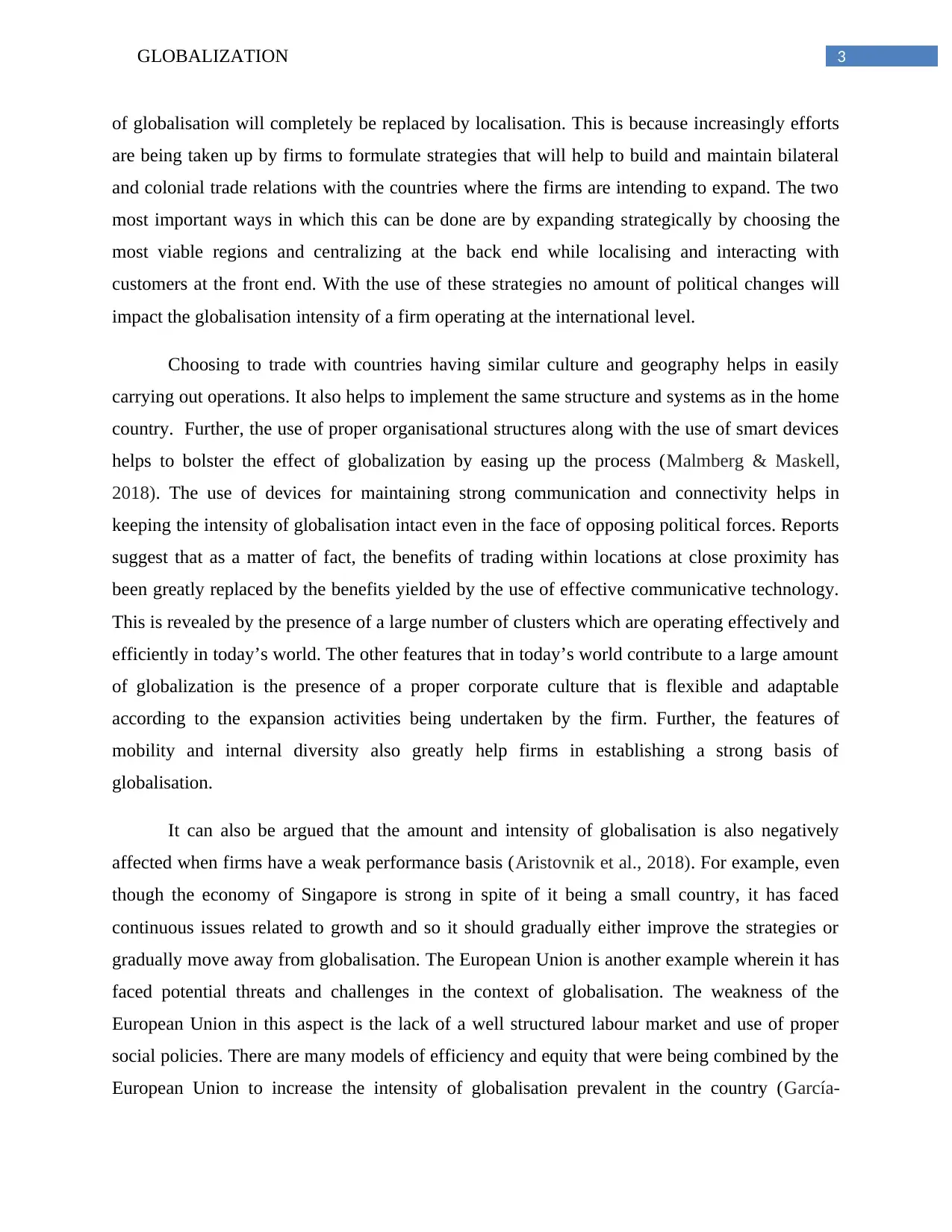
3GLOBALIZATION
of globalisation will completely be replaced by localisation. This is because increasingly efforts
are being taken up by firms to formulate strategies that will help to build and maintain bilateral
and colonial trade relations with the countries where the firms are intending to expand. The two
most important ways in which this can be done are by expanding strategically by choosing the
most viable regions and centralizing at the back end while localising and interacting with
customers at the front end. With the use of these strategies no amount of political changes will
impact the globalisation intensity of a firm operating at the international level.
Choosing to trade with countries having similar culture and geography helps in easily
carrying out operations. It also helps to implement the same structure and systems as in the home
country. Further, the use of proper organisational structures along with the use of smart devices
helps to bolster the effect of globalization by easing up the process (Malmberg & Maskell,
2018). The use of devices for maintaining strong communication and connectivity helps in
keeping the intensity of globalisation intact even in the face of opposing political forces. Reports
suggest that as a matter of fact, the benefits of trading within locations at close proximity has
been greatly replaced by the benefits yielded by the use of effective communicative technology.
This is revealed by the presence of a large number of clusters which are operating effectively and
efficiently in today’s world. The other features that in today’s world contribute to a large amount
of globalization is the presence of a proper corporate culture that is flexible and adaptable
according to the expansion activities being undertaken by the firm. Further, the features of
mobility and internal diversity also greatly help firms in establishing a strong basis of
globalisation.
It can also be argued that the amount and intensity of globalisation is also negatively
affected when firms have a weak performance basis (Aristovnik et al., 2018). For example, even
though the economy of Singapore is strong in spite of it being a small country, it has faced
continuous issues related to growth and so it should gradually either improve the strategies or
gradually move away from globalisation. The European Union is another example wherein it has
faced potential threats and challenges in the context of globalisation. The weakness of the
European Union in this aspect is the lack of a well structured labour market and use of proper
social policies. There are many models of efficiency and equity that were being combined by the
European Union to increase the intensity of globalisation prevalent in the country (García-
of globalisation will completely be replaced by localisation. This is because increasingly efforts
are being taken up by firms to formulate strategies that will help to build and maintain bilateral
and colonial trade relations with the countries where the firms are intending to expand. The two
most important ways in which this can be done are by expanding strategically by choosing the
most viable regions and centralizing at the back end while localising and interacting with
customers at the front end. With the use of these strategies no amount of political changes will
impact the globalisation intensity of a firm operating at the international level.
Choosing to trade with countries having similar culture and geography helps in easily
carrying out operations. It also helps to implement the same structure and systems as in the home
country. Further, the use of proper organisational structures along with the use of smart devices
helps to bolster the effect of globalization by easing up the process (Malmberg & Maskell,
2018). The use of devices for maintaining strong communication and connectivity helps in
keeping the intensity of globalisation intact even in the face of opposing political forces. Reports
suggest that as a matter of fact, the benefits of trading within locations at close proximity has
been greatly replaced by the benefits yielded by the use of effective communicative technology.
This is revealed by the presence of a large number of clusters which are operating effectively and
efficiently in today’s world. The other features that in today’s world contribute to a large amount
of globalization is the presence of a proper corporate culture that is flexible and adaptable
according to the expansion activities being undertaken by the firm. Further, the features of
mobility and internal diversity also greatly help firms in establishing a strong basis of
globalisation.
It can also be argued that the amount and intensity of globalisation is also negatively
affected when firms have a weak performance basis (Aristovnik et al., 2018). For example, even
though the economy of Singapore is strong in spite of it being a small country, it has faced
continuous issues related to growth and so it should gradually either improve the strategies or
gradually move away from globalisation. The European Union is another example wherein it has
faced potential threats and challenges in the context of globalisation. The weakness of the
European Union in this aspect is the lack of a well structured labour market and use of proper
social policies. There are many models of efficiency and equity that were being combined by the
European Union to increase the intensity of globalisation prevalent in the country (García-
Secure Best Marks with AI Grader
Need help grading? Try our AI Grader for instant feedback on your assignments.
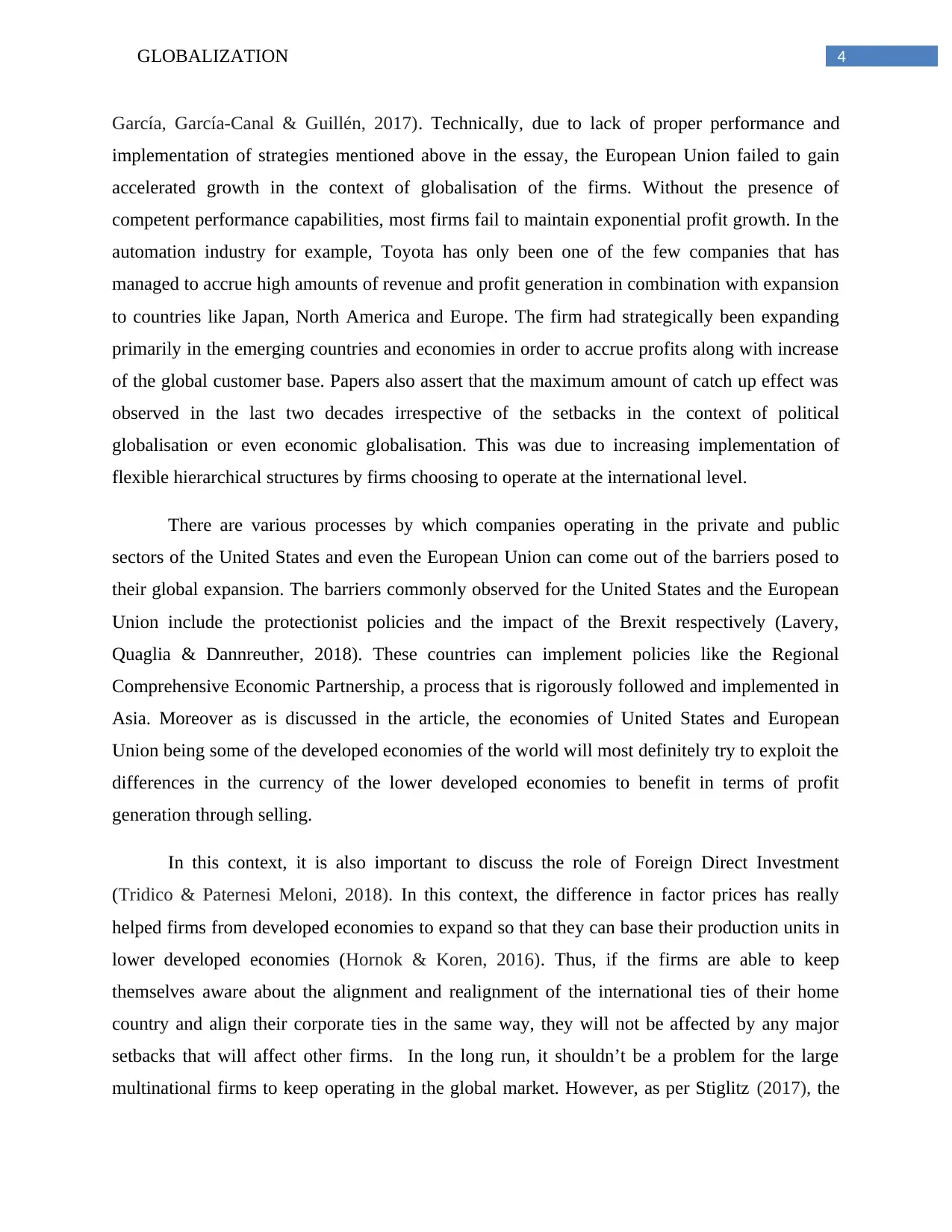
4GLOBALIZATION
García, García-Canal & Guillén, 2017). Technically, due to lack of proper performance and
implementation of strategies mentioned above in the essay, the European Union failed to gain
accelerated growth in the context of globalisation of the firms. Without the presence of
competent performance capabilities, most firms fail to maintain exponential profit growth. In the
automation industry for example, Toyota has only been one of the few companies that has
managed to accrue high amounts of revenue and profit generation in combination with expansion
to countries like Japan, North America and Europe. The firm had strategically been expanding
primarily in the emerging countries and economies in order to accrue profits along with increase
of the global customer base. Papers also assert that the maximum amount of catch up effect was
observed in the last two decades irrespective of the setbacks in the context of political
globalisation or even economic globalisation. This was due to increasing implementation of
flexible hierarchical structures by firms choosing to operate at the international level.
There are various processes by which companies operating in the private and public
sectors of the United States and even the European Union can come out of the barriers posed to
their global expansion. The barriers commonly observed for the United States and the European
Union include the protectionist policies and the impact of the Brexit respectively (Lavery,
Quaglia & Dannreuther, 2018). These countries can implement policies like the Regional
Comprehensive Economic Partnership, a process that is rigorously followed and implemented in
Asia. Moreover as is discussed in the article, the economies of United States and European
Union being some of the developed economies of the world will most definitely try to exploit the
differences in the currency of the lower developed economies to benefit in terms of profit
generation through selling.
In this context, it is also important to discuss the role of Foreign Direct Investment
(Tridico & Paternesi Meloni, 2018). In this context, the difference in factor prices has really
helped firms from developed economies to expand so that they can base their production units in
lower developed economies (Hornok & Koren, 2016). Thus, if the firms are able to keep
themselves aware about the alignment and realignment of the international ties of their home
country and align their corporate ties in the same way, they will not be affected by any major
setbacks that will affect other firms. In the long run, it shouldn’t be a problem for the large
multinational firms to keep operating in the global market. However, as per Stiglitz (2017), the
García, García-Canal & Guillén, 2017). Technically, due to lack of proper performance and
implementation of strategies mentioned above in the essay, the European Union failed to gain
accelerated growth in the context of globalisation of the firms. Without the presence of
competent performance capabilities, most firms fail to maintain exponential profit growth. In the
automation industry for example, Toyota has only been one of the few companies that has
managed to accrue high amounts of revenue and profit generation in combination with expansion
to countries like Japan, North America and Europe. The firm had strategically been expanding
primarily in the emerging countries and economies in order to accrue profits along with increase
of the global customer base. Papers also assert that the maximum amount of catch up effect was
observed in the last two decades irrespective of the setbacks in the context of political
globalisation or even economic globalisation. This was due to increasing implementation of
flexible hierarchical structures by firms choosing to operate at the international level.
There are various processes by which companies operating in the private and public
sectors of the United States and even the European Union can come out of the barriers posed to
their global expansion. The barriers commonly observed for the United States and the European
Union include the protectionist policies and the impact of the Brexit respectively (Lavery,
Quaglia & Dannreuther, 2018). These countries can implement policies like the Regional
Comprehensive Economic Partnership, a process that is rigorously followed and implemented in
Asia. Moreover as is discussed in the article, the economies of United States and European
Union being some of the developed economies of the world will most definitely try to exploit the
differences in the currency of the lower developed economies to benefit in terms of profit
generation through selling.
In this context, it is also important to discuss the role of Foreign Direct Investment
(Tridico & Paternesi Meloni, 2018). In this context, the difference in factor prices has really
helped firms from developed economies to expand so that they can base their production units in
lower developed economies (Hornok & Koren, 2016). Thus, if the firms are able to keep
themselves aware about the alignment and realignment of the international ties of their home
country and align their corporate ties in the same way, they will not be affected by any major
setbacks that will affect other firms. In the long run, it shouldn’t be a problem for the large
multinational firms to keep operating in the global market. However, as per Stiglitz (2017), the
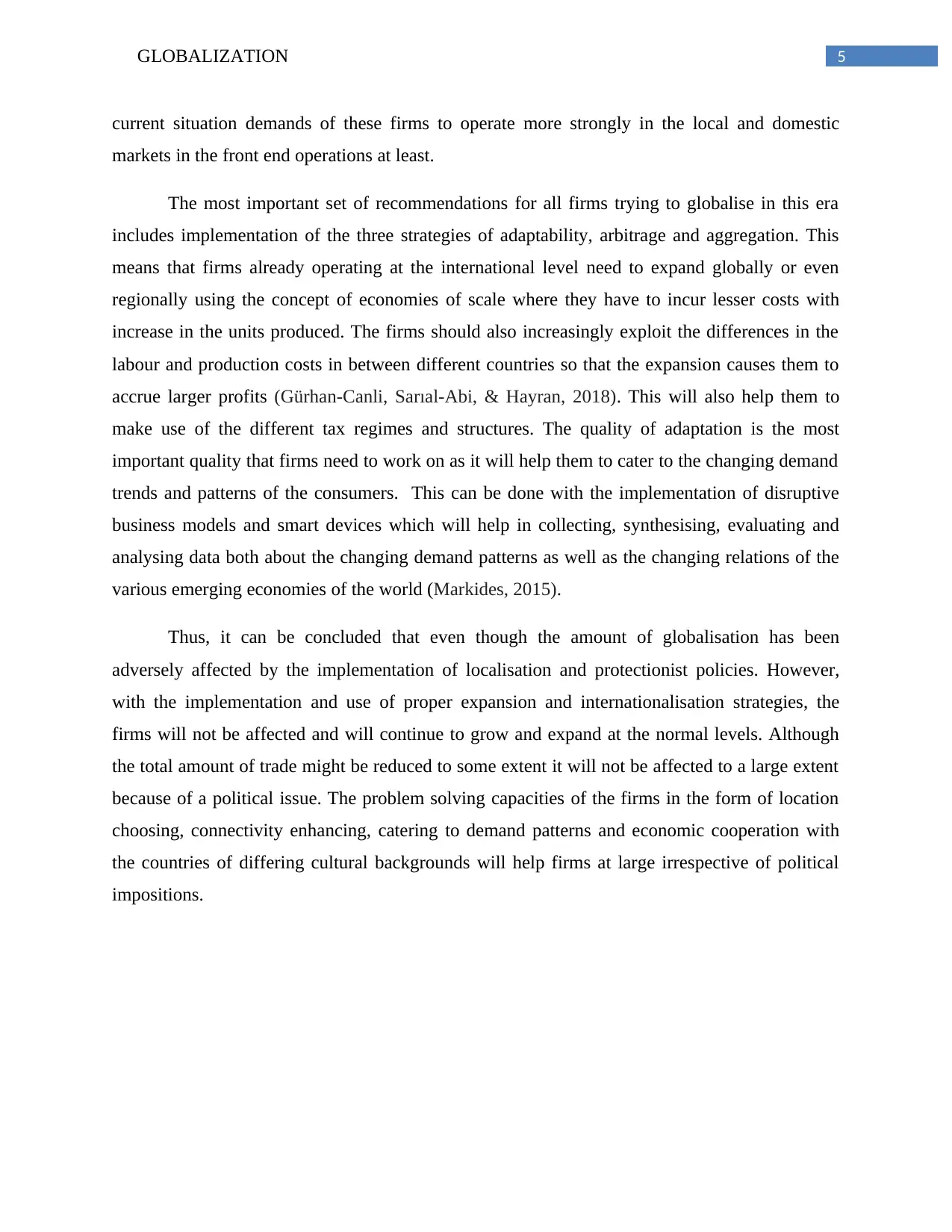
5GLOBALIZATION
current situation demands of these firms to operate more strongly in the local and domestic
markets in the front end operations at least.
The most important set of recommendations for all firms trying to globalise in this era
includes implementation of the three strategies of adaptability, arbitrage and aggregation. This
means that firms already operating at the international level need to expand globally or even
regionally using the concept of economies of scale where they have to incur lesser costs with
increase in the units produced. The firms should also increasingly exploit the differences in the
labour and production costs in between different countries so that the expansion causes them to
accrue larger profits (Gürhan-Canli, Sarıal-Abi, & Hayran, 2018). This will also help them to
make use of the different tax regimes and structures. The quality of adaptation is the most
important quality that firms need to work on as it will help them to cater to the changing demand
trends and patterns of the consumers. This can be done with the implementation of disruptive
business models and smart devices which will help in collecting, synthesising, evaluating and
analysing data both about the changing demand patterns as well as the changing relations of the
various emerging economies of the world (Markides, 2015).
Thus, it can be concluded that even though the amount of globalisation has been
adversely affected by the implementation of localisation and protectionist policies. However,
with the implementation and use of proper expansion and internationalisation strategies, the
firms will not be affected and will continue to grow and expand at the normal levels. Although
the total amount of trade might be reduced to some extent it will not be affected to a large extent
because of a political issue. The problem solving capacities of the firms in the form of location
choosing, connectivity enhancing, catering to demand patterns and economic cooperation with
the countries of differing cultural backgrounds will help firms at large irrespective of political
impositions.
current situation demands of these firms to operate more strongly in the local and domestic
markets in the front end operations at least.
The most important set of recommendations for all firms trying to globalise in this era
includes implementation of the three strategies of adaptability, arbitrage and aggregation. This
means that firms already operating at the international level need to expand globally or even
regionally using the concept of economies of scale where they have to incur lesser costs with
increase in the units produced. The firms should also increasingly exploit the differences in the
labour and production costs in between different countries so that the expansion causes them to
accrue larger profits (Gürhan-Canli, Sarıal-Abi, & Hayran, 2018). This will also help them to
make use of the different tax regimes and structures. The quality of adaptation is the most
important quality that firms need to work on as it will help them to cater to the changing demand
trends and patterns of the consumers. This can be done with the implementation of disruptive
business models and smart devices which will help in collecting, synthesising, evaluating and
analysing data both about the changing demand patterns as well as the changing relations of the
various emerging economies of the world (Markides, 2015).
Thus, it can be concluded that even though the amount of globalisation has been
adversely affected by the implementation of localisation and protectionist policies. However,
with the implementation and use of proper expansion and internationalisation strategies, the
firms will not be affected and will continue to grow and expand at the normal levels. Although
the total amount of trade might be reduced to some extent it will not be affected to a large extent
because of a political issue. The problem solving capacities of the firms in the form of location
choosing, connectivity enhancing, catering to demand patterns and economic cooperation with
the countries of differing cultural backgrounds will help firms at large irrespective of political
impositions.
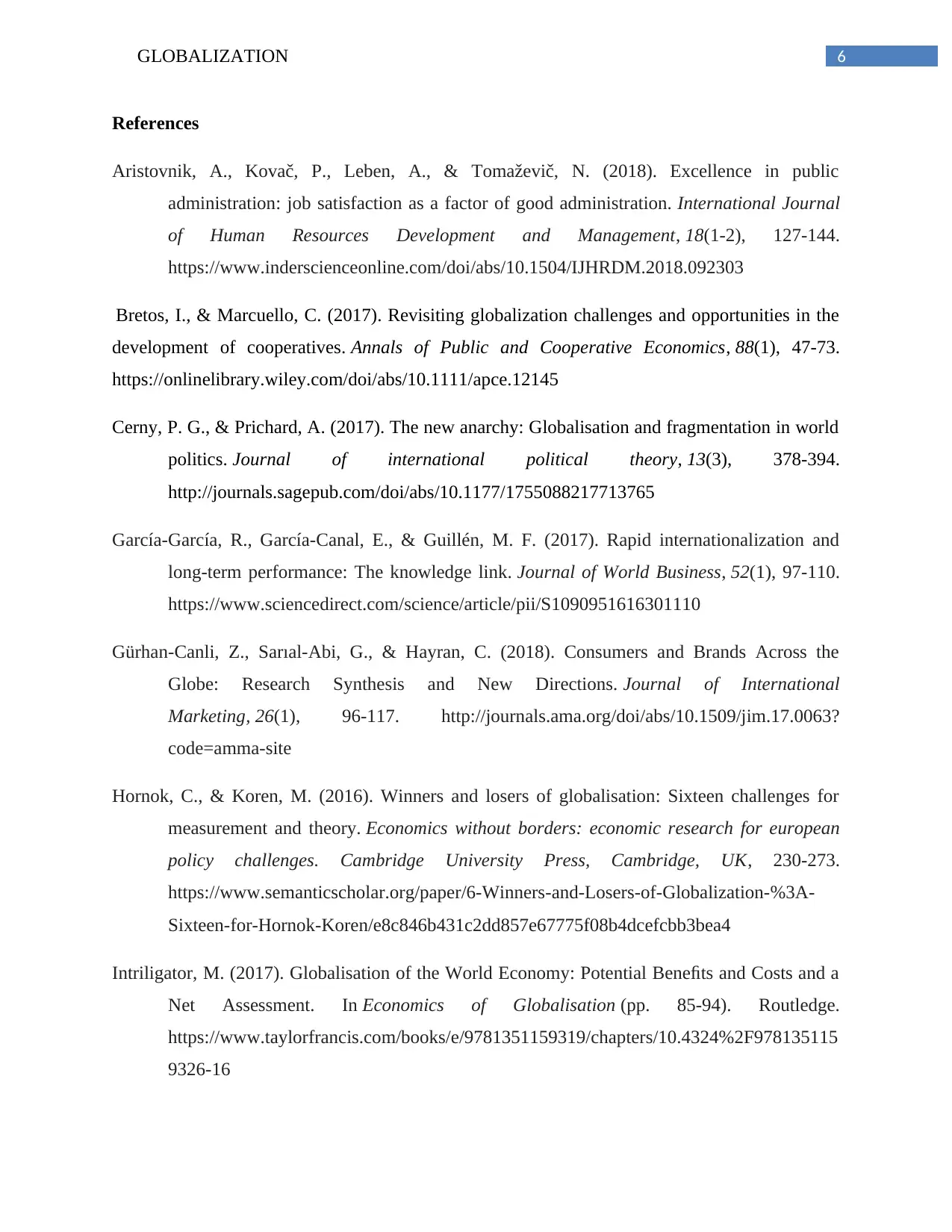
6GLOBALIZATION
References
Aristovnik, A., Kovač, P., Leben, A., & Tomaževič, N. (2018). Excellence in public
administration: job satisfaction as a factor of good administration. International Journal
of Human Resources Development and Management, 18(1-2), 127-144.
https://www.inderscienceonline.com/doi/abs/10.1504/IJHRDM.2018.092303
Bretos, I., & Marcuello, C. (2017). Revisiting globalization challenges and opportunities in the
development of cooperatives. Annals of Public and Cooperative Economics, 88(1), 47-73.
https://onlinelibrary.wiley.com/doi/abs/10.1111/apce.12145
Cerny, P. G., & Prichard, A. (2017). The new anarchy: Globalisation and fragmentation in world
politics. Journal of international political theory, 13(3), 378-394.
http://journals.sagepub.com/doi/abs/10.1177/1755088217713765
García-García, R., García-Canal, E., & Guillén, M. F. (2017). Rapid internationalization and
long-term performance: The knowledge link. Journal of World Business, 52(1), 97-110.
https://www.sciencedirect.com/science/article/pii/S1090951616301110
Gürhan-Canli, Z., Sarıal-Abi, G., & Hayran, C. (2018). Consumers and Brands Across the
Globe: Research Synthesis and New Directions. Journal of International
Marketing, 26(1), 96-117. http://journals.ama.org/doi/abs/10.1509/jim.17.0063?
code=amma-site
Hornok, C., & Koren, M. (2016). Winners and losers of globalisation: Sixteen challenges for
measurement and theory. Economics without borders: economic research for european
policy challenges. Cambridge University Press, Cambridge, UK, 230-273.
https://www.semanticscholar.org/paper/6-Winners-and-Losers-of-Globalization-%3A-
Sixteen-for-Hornok-Koren/e8c846b431c2dd857e67775f08b4dcefcbb3bea4
Intriligator, M. (2017). Globalisation of the World Economy: Potential Benefits and Costs and a
Net Assessment. In Economics of Globalisation (pp. 85-94). Routledge.
https://www.taylorfrancis.com/books/e/9781351159319/chapters/10.4324%2F978135115
9326-16
References
Aristovnik, A., Kovač, P., Leben, A., & Tomaževič, N. (2018). Excellence in public
administration: job satisfaction as a factor of good administration. International Journal
of Human Resources Development and Management, 18(1-2), 127-144.
https://www.inderscienceonline.com/doi/abs/10.1504/IJHRDM.2018.092303
Bretos, I., & Marcuello, C. (2017). Revisiting globalization challenges and opportunities in the
development of cooperatives. Annals of Public and Cooperative Economics, 88(1), 47-73.
https://onlinelibrary.wiley.com/doi/abs/10.1111/apce.12145
Cerny, P. G., & Prichard, A. (2017). The new anarchy: Globalisation and fragmentation in world
politics. Journal of international political theory, 13(3), 378-394.
http://journals.sagepub.com/doi/abs/10.1177/1755088217713765
García-García, R., García-Canal, E., & Guillén, M. F. (2017). Rapid internationalization and
long-term performance: The knowledge link. Journal of World Business, 52(1), 97-110.
https://www.sciencedirect.com/science/article/pii/S1090951616301110
Gürhan-Canli, Z., Sarıal-Abi, G., & Hayran, C. (2018). Consumers and Brands Across the
Globe: Research Synthesis and New Directions. Journal of International
Marketing, 26(1), 96-117. http://journals.ama.org/doi/abs/10.1509/jim.17.0063?
code=amma-site
Hornok, C., & Koren, M. (2016). Winners and losers of globalisation: Sixteen challenges for
measurement and theory. Economics without borders: economic research for european
policy challenges. Cambridge University Press, Cambridge, UK, 230-273.
https://www.semanticscholar.org/paper/6-Winners-and-Losers-of-Globalization-%3A-
Sixteen-for-Hornok-Koren/e8c846b431c2dd857e67775f08b4dcefcbb3bea4
Intriligator, M. (2017). Globalisation of the World Economy: Potential Benefits and Costs and a
Net Assessment. In Economics of Globalisation (pp. 85-94). Routledge.
https://www.taylorfrancis.com/books/e/9781351159319/chapters/10.4324%2F978135115
9326-16
Paraphrase This Document
Need a fresh take? Get an instant paraphrase of this document with our AI Paraphraser
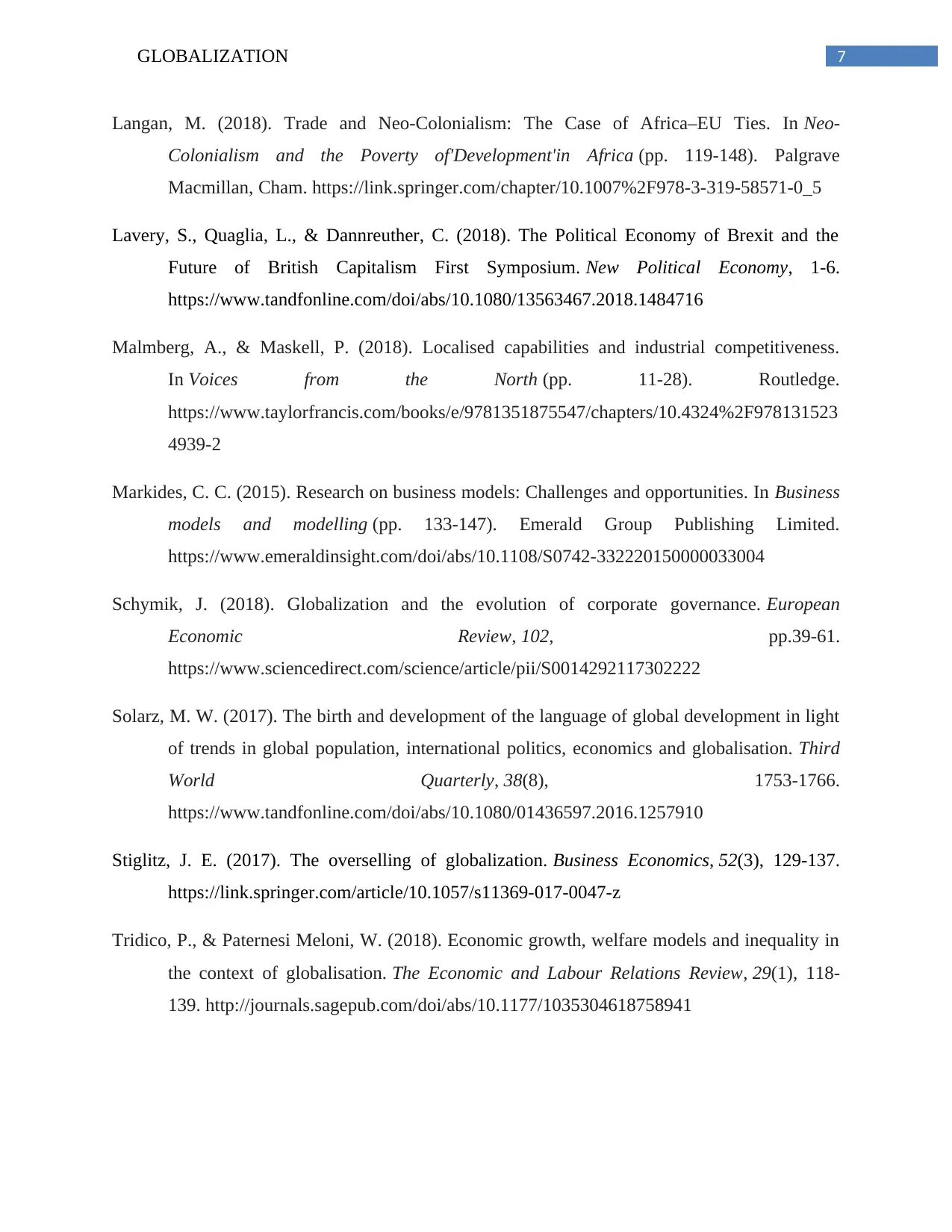
7GLOBALIZATION
Langan, M. (2018). Trade and Neo-Colonialism: The Case of Africa–EU Ties. In Neo-
Colonialism and the Poverty of'Development'in Africa (pp. 119-148). Palgrave
Macmillan, Cham. https://link.springer.com/chapter/10.1007%2F978-3-319-58571-0_5
Lavery, S., Quaglia, L., & Dannreuther, C. (2018). The Political Economy of Brexit and the
Future of British Capitalism First Symposium. New Political Economy, 1-6.
https://www.tandfonline.com/doi/abs/10.1080/13563467.2018.1484716
Malmberg, A., & Maskell, P. (2018). Localised capabilities and industrial competitiveness.
In Voices from the North (pp. 11-28). Routledge.
https://www.taylorfrancis.com/books/e/9781351875547/chapters/10.4324%2F978131523
4939-2
Markides, C. C. (2015). Research on business models: Challenges and opportunities. In Business
models and modelling (pp. 133-147). Emerald Group Publishing Limited.
https://www.emeraldinsight.com/doi/abs/10.1108/S0742-332220150000033004
Schymik, J. (2018). Globalization and the evolution of corporate governance. European
Economic Review, 102, pp.39-61.
https://www.sciencedirect.com/science/article/pii/S0014292117302222
Solarz, M. W. (2017). The birth and development of the language of global development in light
of trends in global population, international politics, economics and globalisation. Third
World Quarterly, 38(8), 1753-1766.
https://www.tandfonline.com/doi/abs/10.1080/01436597.2016.1257910
Stiglitz, J. E. (2017). The overselling of globalization. Business Economics, 52(3), 129-137.
https://link.springer.com/article/10.1057/s11369-017-0047-z
Tridico, P., & Paternesi Meloni, W. (2018). Economic growth, welfare models and inequality in
the context of globalisation. The Economic and Labour Relations Review, 29(1), 118-
139. http://journals.sagepub.com/doi/abs/10.1177/1035304618758941
Langan, M. (2018). Trade and Neo-Colonialism: The Case of Africa–EU Ties. In Neo-
Colonialism and the Poverty of'Development'in Africa (pp. 119-148). Palgrave
Macmillan, Cham. https://link.springer.com/chapter/10.1007%2F978-3-319-58571-0_5
Lavery, S., Quaglia, L., & Dannreuther, C. (2018). The Political Economy of Brexit and the
Future of British Capitalism First Symposium. New Political Economy, 1-6.
https://www.tandfonline.com/doi/abs/10.1080/13563467.2018.1484716
Malmberg, A., & Maskell, P. (2018). Localised capabilities and industrial competitiveness.
In Voices from the North (pp. 11-28). Routledge.
https://www.taylorfrancis.com/books/e/9781351875547/chapters/10.4324%2F978131523
4939-2
Markides, C. C. (2015). Research on business models: Challenges and opportunities. In Business
models and modelling (pp. 133-147). Emerald Group Publishing Limited.
https://www.emeraldinsight.com/doi/abs/10.1108/S0742-332220150000033004
Schymik, J. (2018). Globalization and the evolution of corporate governance. European
Economic Review, 102, pp.39-61.
https://www.sciencedirect.com/science/article/pii/S0014292117302222
Solarz, M. W. (2017). The birth and development of the language of global development in light
of trends in global population, international politics, economics and globalisation. Third
World Quarterly, 38(8), 1753-1766.
https://www.tandfonline.com/doi/abs/10.1080/01436597.2016.1257910
Stiglitz, J. E. (2017). The overselling of globalization. Business Economics, 52(3), 129-137.
https://link.springer.com/article/10.1057/s11369-017-0047-z
Tridico, P., & Paternesi Meloni, W. (2018). Economic growth, welfare models and inequality in
the context of globalisation. The Economic and Labour Relations Review, 29(1), 118-
139. http://journals.sagepub.com/doi/abs/10.1177/1035304618758941
1 out of 8
Related Documents
Your All-in-One AI-Powered Toolkit for Academic Success.
+13062052269
info@desklib.com
Available 24*7 on WhatsApp / Email
![[object Object]](/_next/static/media/star-bottom.7253800d.svg)
Unlock your academic potential
© 2024 | Zucol Services PVT LTD | All rights reserved.





